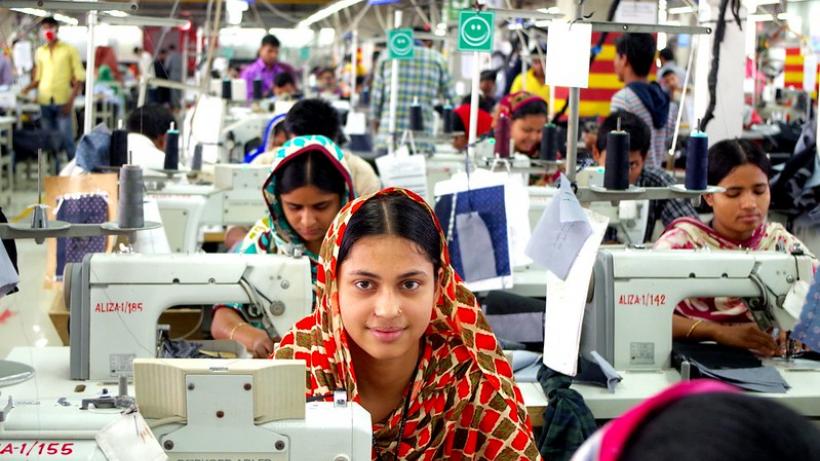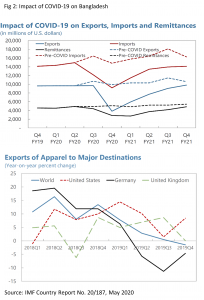
Building back better: Fostering gender equality in Bangladeshi readymade garment industry
Post-COVID-19 recovery in one of Bangladesh’s largest industries could lead to increased inclusivity thanks to external market pressures.
Editor's note: This blog is part of our International Women's Day campaign and contains findings from this IGC project.
In Bangladesh, inclusive and resilient employment generation has received considerable policy focus as a sustainable pathway for economic recovery following the COVID-19 pandemic. The economic challenges triggered by the pandemic are daunting and there is widespread concern that the pandemic may aggravate existing gender gaps in the labour market.
The Bangladeshi labour market has historically struggled to broaden the economic inclusion of women—reflected in low Female Labour Force Participation (FLFP) and the low share of women in non-agricultural employment. FLFP in Bangladesh grew from a modest level of 27.5% in 2003 to 37.4% in 2016. However, it remains low compared to both lower-middle and middle income countries, which respectively average 39% and 48% FLFP. A more concerning trend is that, since 2010, female labour force participation in urban areas have declined.
Labour force participation rate (age 15-64): by sex and location, 2003-16

A Jobs Diagnostic conducted in 2017 reports that, even after accounting for the structural transformation of the economy and demographic dynamics, FLFP is impeded by unfavourable gender norms as a major supply side obstacle. These include restrictions on mobility, constraints on ownership rights of productive assets and expectations that primary commitment remains towards household responsibilities. Lack of access to safe transport is a binding constraint and many women face limited access to business networks and trade associations which undermines propensity to engage in entrepreneurship, trade, and training and in the marketplace. On the demand side, constraints include a lack of equal pay, poor carrier progression, and widespread workplace harassment and labour abuse.
Increased female employment fails to ensure gender equality
The growth spurt in FLFP in the last decade has been partly attributed to the expansion of the readymade garments (RMG) industry. Bangladesh is currently the leading exporter of RMG in the world, and the sector is considered as one of the key drivers of Bangladesh’s employment and economic growth. The labour-intensive nature of the industry allowed for the creation of more than 4 million jobs from 2003-18 and played a pivotal role in the country’s structural transformation.
The industry’s expansion over the last two decades also ushered in large scale formal off-farm employment for hundreds of thousands of women. Based on the Economic Census 2013 of Bangladesh Bureau of Statistics, RMG sector had one of the highest shares of female employment in manufacturing—approximately 54%.
However, the RMG industry’s headline employment statistic masks significant underlying gaps in gender attainment. A recent research on Bangladesh readymade garments factory finds gender gaps in wages comparable to that found in the literature for higher-income countries; an interesting dissimilarity is that motherhood does not explaining much of the wage gap for Bangladesh. Using administrative records for more than 80,000 workers from 70 large garment factories in Bangladesh, among production workers, the research finds that men are paid on average around 8% more than women[1]. The male production workers have faster promotion rates within and across-factory promotions which explains the emergence of the gender gap over workers’ careers. The differences in skills between male and female workers explain only 50% of wage gaps and differences in the rate of internal promotion. An ILO report finds that female representation in managerial and leadership positions in the RMG sector has remained unchanged between 2010 and 2018; women workers are concentrated in low rungs (paygrade scale) of the production workforce.
COVID-19 has had direct implications for the RMG industry
Readymade garments (RMG) accounts for more than 80% of Bangladesh’s total export earnings and are one of the main sources of formal sector employment. The sector has been heavily affected by the slump in apparel demand in Europe, the US, Canada, and other key export destinations. In early April 2020, the Bangladesh Garment Manufacturers and Exporters Association (BGMEA) reported cancellation of nearly US$ 3.15 billion in export. Of the estimated 3.5 million Bangladeshis working in the garment sector and it has been reported nearly one million workers may have experienced either temporary or permanent lay off.

COVID-19 response strategies signal opportunities for better labour practices in the future
Researchers based at Columbia University, University of Washington, and BRAC Institute of Governance and Development, BRAC University have been investigating the effect of employer responses to COVID-19 on female garment workers in Bangladesh. The motivation of the research is well within the government’s inclusive growth strategy.
Due to field work restrictions imposed due to COVID-19 pandemic, the research utilised randomised Respondent Driven Sampling (RRDS) sampling strategy to generate a representative sample of garment workers. As of March 2020, the researchers surveyed 1,552 out of an anticipated 2800 garment workers. The preliminary findings suggest that during the pandemic, employment in garment factories often leads to higher monthly income than alternatives, although the gender pay gap persists. The research is ongoing and is preliminary results indicate the COVID-19 pandemic has impacted employment, wages and non-pecuniary benefits in the RMG sector. The extent of these cutbacks vary from factory to factory. There is preliminary evidence to suggest that workers in factories that supply to compliance-oriented buyers and global brands have reported lower wage cutbacks, better provision of sick leave and benefits, and better provision of hygiene facilities at the workplace[2]. The findings also suggest a wide variation between factories on reported stress level and labour management practices
The RMG industry’s recovery—and inclusivity—could hinge on external markets
The RMG sector is critical employment and growth and also provides an entry point for reforms in management practice and norms that may bear considerable positive spill overs for economic inclusivity.
It appears that stakeholders at RMG destination markets could be mobilised to play a non-trivial role for the sector’s more inclusive and equitable recovery. There is evidence that the RMG global value chain business model affords global brands and international buyers’ considerable abilities to influence the attainment and safeguarding of better managerial and compliance standards. A research which partnered with a set of multinational retail and apparel firms to enforce local labour laws on their suppliers in Bangladesh and found that buyers can enforce labour laws in environments where the state lacks capacity. Importantly, these improvements did not appear to come at significant costs to suppliers in terms of efficiency.
In light of these evidence and insights, it is clear that public sector would continue to play central role to improve women’s labour force participation through provision of safe transport and availability of affordable quality childcare. At the same time, global brands’ preference for gender and labour law compliant supply chain can be leveraged within the RMG sector to foster gender equity so we might emerge out of the economic downturn on more robust and equitable growth trajectory.
[1] the salary data come from electronic wage records of the factories, and are therefore measured with minimal error.
[2] Workers who are employed in factories that were previously under Alliance and Accord report better provision of hygiene at workplace and better benefits.

